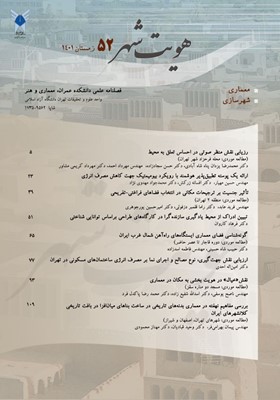نقش«خیال» در هویت بخشی به مکان در معماری (مطالعه موردی: مسجد دو مناره سقز)
محورهای موضوعی : معماری
ناصح یوسفی
1
![]() ,
اسدالله شفیع زاده
2
,
محمد رضا پاکدل فرد
3
,
اسدالله شفیع زاده
2
,
محمد رضا پاکدل فرد
3
1 - دانشجوی دکترای معماری، واحد اهر، دانشگاه آزاد اسلامی، اهر ، ایران
2 - استادیار گروه معماری، واحد اهر، دانشگاه آزاد اسلامی، اهر، ایران
3 - استادیار گروه معماری، واحدتبریز، دانشگاه آزاد اسلامی، تبریز، ایران
کلید واژه: عالم خیال, فلسفه, خیال, مکان, معماری,
چکیده مقاله :
هدف این پژوهش بررسی نقش خیال در هویت بخشی به مکان در معماری است. روش پژوهش به صورت آمیخته است. تعداد نمونه در بخش کیفی 15 مقاله و 9 خبره در امر معماری شهری است و از روش نمونه گیری هدفمند منابع و گلوله برفی خبرگان انتخاب شدند. نمونه در بخش کمی برای تکنیک دیمتل 9 نفر بر اساس روش گلوله برفی انتخاب شدند.. برای تفسیر در بخش کیفی از روش تحلیل مضمون برای استخراج مضامین از نرم افزار مکس کیوآدا 12 استفاده شد. در بخش کمی از تکنیک دیمتل از نرم افزار اکسل استفاده شد. نتایج نشان داد که مکان، هویت و اعتبار خود را از معانی و مفاهیمی که ناظر و کاربر آن در ذهن می پروراند، می گیرد. خیال یکی از مهمترین قابلیت های انسانی است که با توانایی هایی که دارد، می تواند بسیاری از رویدادهای ذهنی در جهت هویت بخشی به مکان را ایجاد نماید.
The word "Imagination" has been introduced in different meanings in different sciences. Imagination is one of the special abilities of human beings, which includes a significant field in Islamic philosophy and wisdom. And can play an important role in the analysis, cognition and creation of many phenomena; To guide man to the land of the unknown and truths with imagination and mental abilities.Also, in relation to the subject of the place of research, many different psychological, phenomenological, etc. angles have been done;Place is the mathematical space that has meaning. The place derives its identity and validity from the meanings and concepts that the observer and its user cultivate in their minds. These concepts include several factors such as: physical and physical factors of the place, human behaviors formed in it and finally the mental events of observers and users. Imagination is one of the most important human abilities that with its abilities, it can create many mental events in order to identify the place. In connection with the word "fantasy" in philosophy, valuable topics can be found in various ways. It has been researched with various approaches such as Eastern and Western views as well as views of various religious sources and sciences. Man's presence in space, his data and sensory perceptions, his experience of space, his fantasies and imagination, his presuppositions and presuppositions, and even his mental myths and legends are discussed. By examining the past works of architecture and urban planning, one can see the traces of the manifestation of the world of illusion and imagination in works of art.in this study, the "Domnareh" mosque from the valuable and old buildings of the Afshari period in the ancient city of Saqez was selected as a case study in relation to the subject of research and was analyzed and evaluated.In this article, we want to answer the following questions: What is the role of imagination and fantasy in identifying and giving meaning to a place? And to what extent can the imaginative minds of designers before design, and users after execution, be effective in giving meaning to a place?The purpose of this study is to investigate the role of "imagination" in identifying space in architecture. The research method is mixed. The number of samples in the qualitative section is 15 articles and 9 experts in urban architecture and experts were selected from the method of targeted sampling of resources and snowballs. Samples were selected in the quantitative part for the Demetel technique based on the snowball method. For interpretation in the qualitative part, the content analysis method was used to extract the themes from MAXQDA12 software. In a small part of the Demitel technique, Excell software was used. The results showed that the place derives its identity and validity from the meanings and concepts that the observer and its user cultivate in the mind. Imagination is one of the most important human capabilities that with its abilities, it can create many mental events in order to identify the place.
https://wisdom.ihcs.ac.ir/article_2508.html
_||_

